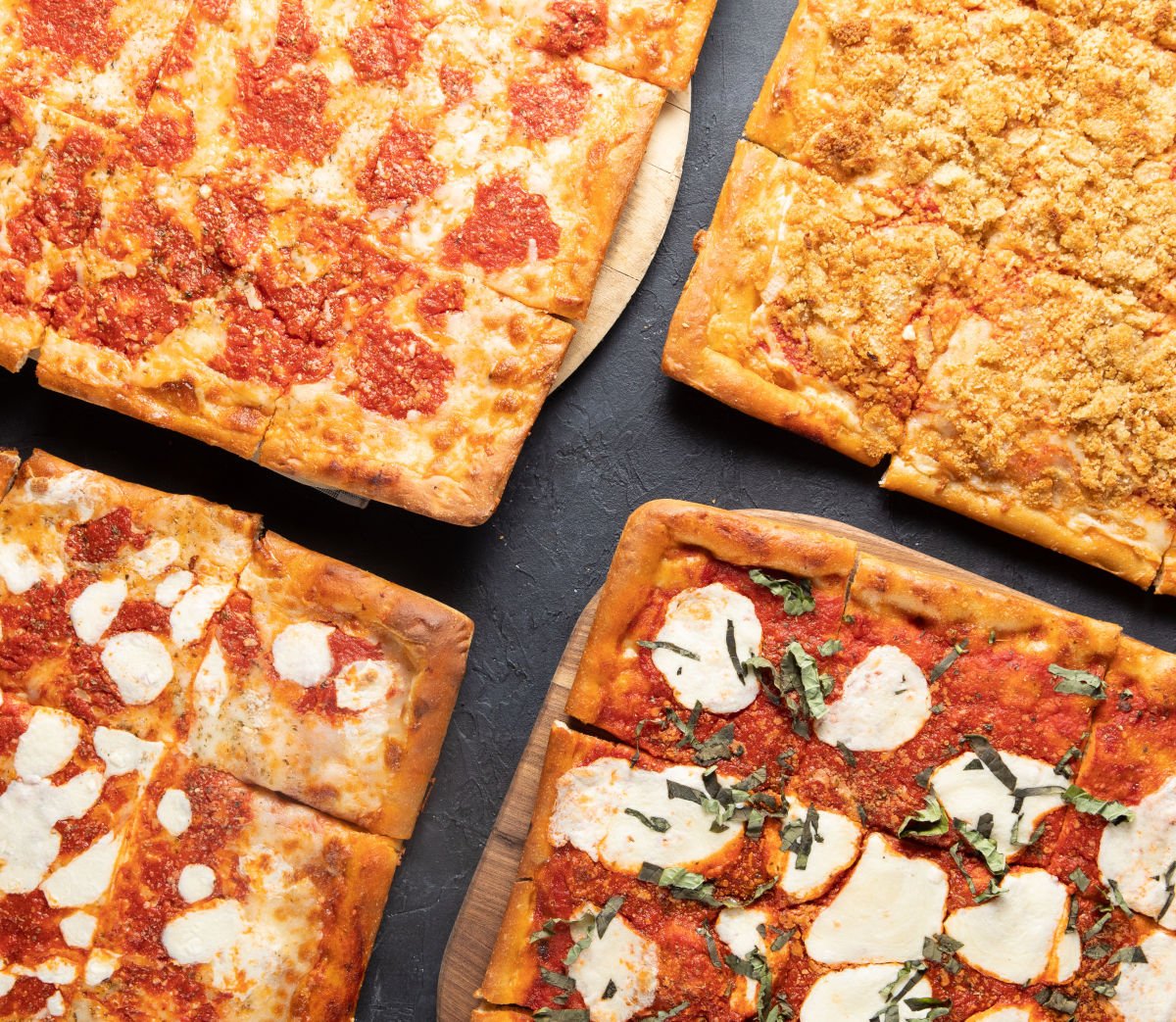Grandma Pizza – The Underdog of Square Pies
Sicilian Pizza, Detroit Style, Grandma Pie. There is something very hip about a square pizza slice, especially when that slice has roots deep into Italian home cooking. Detroit and Sicilian Pizzas though with their thick, spongy almost focaccia-like crusts, meant to satisfy the hungriest of customers have prevailed in popularity. American food culture has always been one of abundance so the “food porn” qualities of Detroit and Sicilian Pizza have captured the hearts and social media feeds of all pizza lovers. But away from the noise of the Square Pie wars, a refined & elegant pizza rises. What is it about the Grandma Pie that makes it stand out? Is it the elegance or the genius simplicity of it? Let’s dive into the world of Nonna Pies and see how things pan out (sorry I am now contractually obligated to have at least one pizza pun per article!)
Sal’s Pizzeria is known as the “Home of the Grandma Slice” but what exactly is Grandma Pizza? When and where does it come from? Where did the cheese go? (Hint: it’s UNDER the sauce!) How did the socio-cultural background of Old-World immigrants affect the infamous pizza? Is it really hip to eat squares? Does baking pizza in a pan a la Nonna make it a healthier alternative? Answers to all of these and more burning questions to follow. But first a bit of history…
Who invented the Grandma Pie?
Story of the Grandma Pie, a NY original pizza
As with many things NY, the origin of the Grandma Pie is fuzzy at best. In such a huge city, ideas are easy to come by, resources (or resourcefulness even better…) are plenty, and the market is HUGE! These ideal conditions have fueled the NY restaurant scene for decades now, making it the culinary epicenter not just of the US but the world. Can’t talk about NY restaurants though without mentioning the pizza, right? The iconic New York slice, depicted in countless movies and tv shows has a story of its own (you can read it here: What is NY Style Pizza?) but from the staff or better yet “family” meals of pizzerias in Long Island, the underdog of all pizza emerges. The Grandma Pie is an easy and quick version of a traditional Sicilian housewife classic, that does not require extensive proofing times and is economical in the equipment and utensils it requires.
Why is it called “Grandma Pie”?
Pizza alla Nonna (translation: Pizza Grandma Style) was developed by first generation Italian immigrants in the boroughs of New York. It holds its origins in the traditional Italian Pizza alla Casalinga (translation: Pizza Housewife Style). In Italy, Pizza alla Casalinga was a quick and easy way to feed hungry kiddos and house guests. A quick dough is stretched in a pan coated with olive oil. Fresh or crushed tomatoes mixed with garlic on top and a generous sprinkle of Pecorino or Parmesan would complete the quick homemade snack. Of course, there was no time to proof the dough (hangry kids is a big NO-NO in Italian tradition!) or to go to the communal wood burning oven, which would traditionally bake pizzas at 900F. In a regular Italian home, a 900F oven is not a staple, so house cooks made with what they had, which was your regular electric or gas stove oven. To accommodate for the lower cooking temperature the consistency of the dough as well as the quantity of toppings would have to be adjusted so it could bake at lower temperature and for longer times.
From a quick meal for a family to “Family Meal” in restaurants.
But how did we get from quick homemade family meal to popular menu item in restaurants?
“Family Meal” or simply “Family” has a whole other meaning in the restaurant industry. “Family” is assigned as a duty to one of the cooks and it is just as important as any task in the whole kitchen. The cook preparing “Family” is responsible for feeding the whole restaurant crew, in the most efficient and economical way possible. So, they needed something that can be made with leftover ingredients of a pizza restaurant, cooks relatively fast, doesn’t require a bunch of containers or special equipment and comes in a convenient square pan that occupies the scarce oven space in a more efficient way (square pans fit better in square ovens, there is loss of surface between 2 round pizzas…get it??).
Enter the Grandma Pizza!
Inspired by the resourcefulness of their Nonna’s, Long Island pizzaiolos in the early 70’s started making Grandma Pies for Family Meal in their restaurants. Occasionally these pies would make to the slice table and would pick up in popularity among customers over the years. The Long Island pizzeria that is most credited for the creation and popularization of the Grandma Pie was Umberto’s of New Hyde Park. There are of course other pizzerias that hold similar claims, but from our research all roads lead to Umberto’s.
What is the difference between a Grandma Pie and Sicilian? Is a Grandma slice healthier than regular pizza?
The answer is deceivingly simple: It all has to do with the anatomy of the pizza!
There are countless variations of Grandma Pies across NY. Most recently popular is the Upper East Side version, which is closer to the traditional Italian version, with a thin crust, easy cheese, easy sauce. Sometimes no sauce at all, just fresh crushed tomatoes with garlic and olive oil. That sounds pretty healthy right? Upper East Siders seem to think so!
What is Grandma Pie on Jersey Shore?
Other pizza joints in Jersey Shore choose a heartier version, heavier on the cheese and putting a thick red sauce on top of the cheese and maybe some Pepperoni or Sausage while they are at it. That doesn’t sound so healthy right? Jersey people don’t seem to care though!
What makes a Grandma pizza different?
There is a set of attributes though, directly linked to Grandma Pies, that have been agreed upon by all pizza scholars.
Needs to be cooked in a square olive oil coated pan
Cheese in on the bottom, sauce goes on top
Dough is not proofed resulting in a denser & crispier crust
What makes Sal’s Grandma Slice special?
Even though very similar to our Sicilian pizza, the Grandma Pie has some distinct characteristics that make it different. The dough on a Grandma Pie is not proofed so it is not as spongy and chewy as a Sicilian. The thin crust dictates by itself the number of toppings that can go on a Grandma Pie. No “The Works” or “Supreme” on a Grandma crust. The fewer ingredients the better. That way the quality of them shines through. The crust is double baked for extra crispiness, coated with a healthy drizzle of extra virgin Sicilian Olive Oil, and chopped garlic. Then, the mozzarella cheese blend is complimented with Pecorino Romano to form a thin bed for the chunky “Grandma Style Sauce”. Ours is a variation of our Pizza Sauce reinforced with extra herbs & spices and cooked hot and fast instead of the traditional low & slow method. We hit it with fresh basil, oregano & Pecorino Romano while hot out of the oven and you have the square masterpiece. Sal’s mother had her own variation on the Grandma Pizza which she topped with sautéed Breadcrumbs & Onions – one of the most popular Grandma Pies we offer to date at Sal’s Pizzerias.
How many slices are in a Grandma Pie?
Answer: 9 slices, square cut, medium crust; 1 middle slice, 4 corner slices, and 4 side slices.
So, there you have it, don’t be a square, eat squares instead. Mangia!



